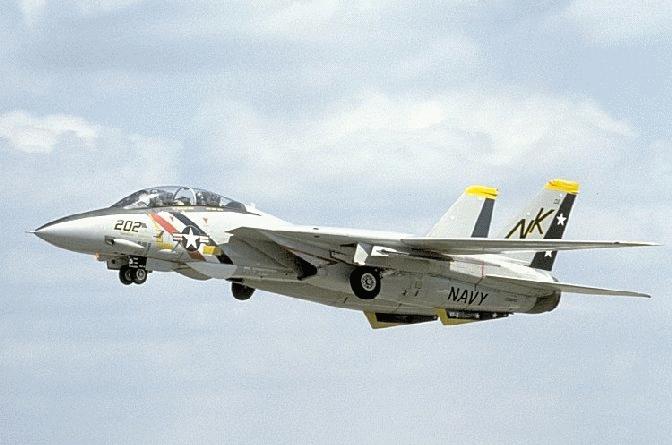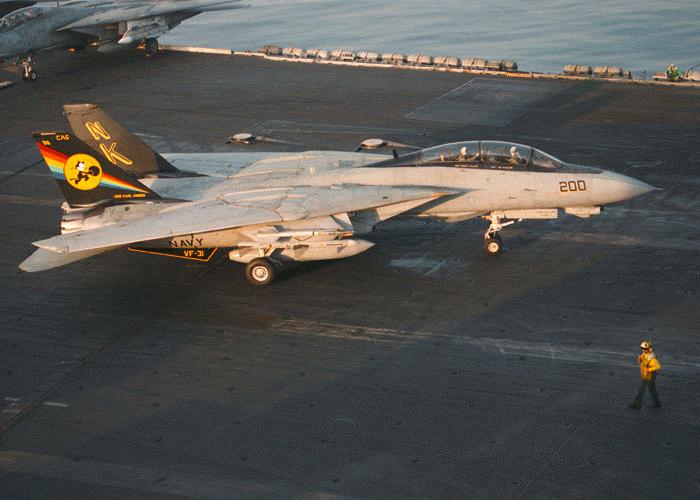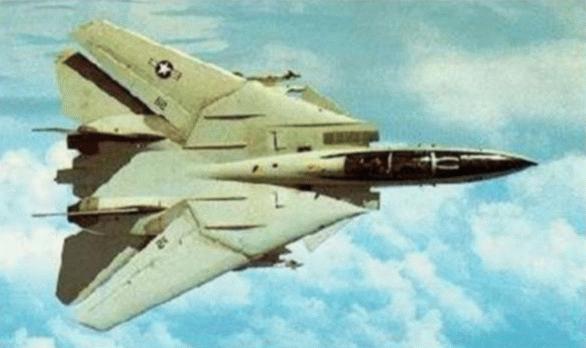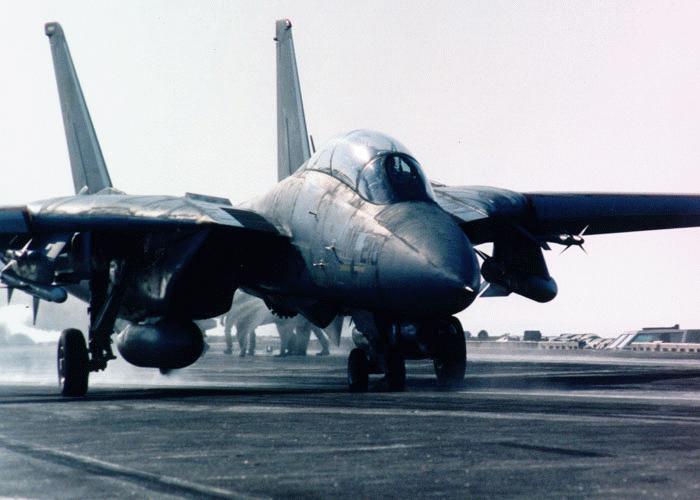The F-14 Tomcat is a supersonic, twin-engine, variable sweep-wing fighter plane designed in the mid 1970s for the US
Navy. It is extremely manouverable and can easily outrun and outfight almost any other fighter jet. It is excellent at dogfighting,
but also carries the AIM-54 missile, the longest-range air-to-air missile in the world.
The F-14 won the US Navy VRX fighter competition in January 1969. The first flight of twelve development aircraft was
in December 1970. The F-14A, the first version of the F-14, was deployed with US Navy squadrons VF-1 and VF-2 in October 1972.
A total of 557 aircraft were delivered to the Navy by April 1987.
The first version of the F-14, the F-14A, is the basic platform for the F-14 series. It has two TF30-P-414A engines.
F-14A aircraft were upgraded to extend the life of the airframes. Changes included adding the AN/ALR-67 Countermeasure Warning
and Control System, LANTIRN and the Programmable Tactical Information Display (PTID). The Automatic Flight Control System
(AFCS) was replaced with the Digital Flight Control System (DFCS). These upgrades did not change the designation of the F-14A.
About sixty F-14A aircraft had these upgrades.

The F-14B is either a remanufactured F-14A or a new production aircraft. The B model is equipped with F110-GE-400 engines,
replacing the TF30-P-414A engines on the F-14A, a new, more reliable design which requires less maintenence. The new engines
improved manouverability without throttle restrictions or engine trimming. About seventy F-14Bs were upgraded in the
early 2000s to extend the life of the airframes. These upgrades included adding the Fatigue Engine Monitoring System, AN/ALR-67
Countermeasure Warning and Control System, Gun Gas Purge Door Engineering Change Proposal (ECP), Direct Lift Control/Approach
Power Compensator ECP, AN/AWG-15F ECP and Engine Door Tension Fittings ECP. In addition, the AN/ASN-92 Carrier Aircraft Inertial
Navigation System (CAINS) I was replaced with the Embedded GPS Inertial (EGI) Navigation System. The F-14B upgrade also included
a MIL-STD-1553B Digital Multiplex Data Bus (DMDB), Programmable Multi-Display Indicator Group (PMDIG), PTID, the AN/AWG-15H
Fire Control System, AN/ALR-67D(V)2 Radar Warning Reciever, EGI and Mission Data Loader.

The F-14D is the latest version of the F-14, and is either a remanufactured F-14A or a new production aircraft. Production
shifted to the F-14D in 1988, and it became operational in 1992. Like the F-14B, the F-14D has F110-GE-400 engines, but it
also has new radar and new avionics systems. The F-14D also has changes to the airframe and electronic countermeasure systems.
Changes include a Naval Flight Officer (NFO) armament control panel, pilot air combat manouvering panel and emergency jettison
panel which enhance the offense and defense of the F-14. The AN/APG-71 radar replaces the old AN/AWG-9 radar used in the F-14A
and B and has fewer Weapon Replaceable Assemblies (WRAs), reducing both weight and space requirements. Major changes were
made to the signal processor, data processor, digital display, central processor, recievers and antenna configuration.

The F-14 has taken part in many battles since it first flew in 1970. F-14s provided air cover for the joint strike on
Libyan terrorist targets in 1986. It was also used a lot during Desert Storm in 1991, and in Operation Enduring Freedom in
2001 and Operation Iraqi Freedom in 2003. Two US Navy F-14s also engaged two Libyan Su-22 fighter jets off the Libyan coast
in 1981. The F-14s shot down the Su-22s with no losses. This happened again in 1989. Two US Navy F-14s shot down two Libyan
MiG-23 fighters off the Libyan coast with no losses. In both incidences it appeared as though the Libyan aircraft were trying
to engage the American fighters.

After thirty years of service, the F-14 was retired by the US Navy in 2006. The last F-14 mission took place over Iraq,
where a Navy F-14 dropped a bomb on a target there. The US Navy's F-14 fleet is being replaced by the newer F/A-18 Super Hornet
carrier-launched fighters. Many people consider the F-14 to be a better aircraft than the Super Hornet, but the F/A-18 requires
much less maintenence. The F-14 also uses a lot of technology from the 1970s, while the F/A-18 is a much newer plane. F-14s
are still in service with the Islamic Republic of Iran Air Force, although Iran may soon be retiring their F-14s and replacing
them with a different type of fighter. Rumours are it may be the MiG-31 Foxhound. An Iranian F-14 is pictured below.
Primary function: Carrier-based multi-role strike fighter
Contractor: Grumman Aerospace Corporation
Propulsion: Two General Electric F-110-GE-400 turbofan engines with afterburners
Thrust: 27,000 pounds (12,150 kilograms) per engine
Length: 61 feet, 9 inches (18.6 metres)
Height: 16 feet (4.8 metres)
Wingspan: 64 feet (19 metres) unswept, 38 feet (11.4 metres) swept
Maximum take-off weight: 72,900 pounds (32,805 kilograms)
Ceiling: Above 53,000 feet
Maximum speed: Mach 2.04
Crew: Two (pilot and radar intercept officer)
Armament: Up to six AIM-7 Sparrow, four AIM-9 Sidewinder or six AIM-54 Phoenix air-to-air missiles or up to 13,000 pounds
of air-to-ground ordnance
Cost: $38 million
Date deployed: 1970

